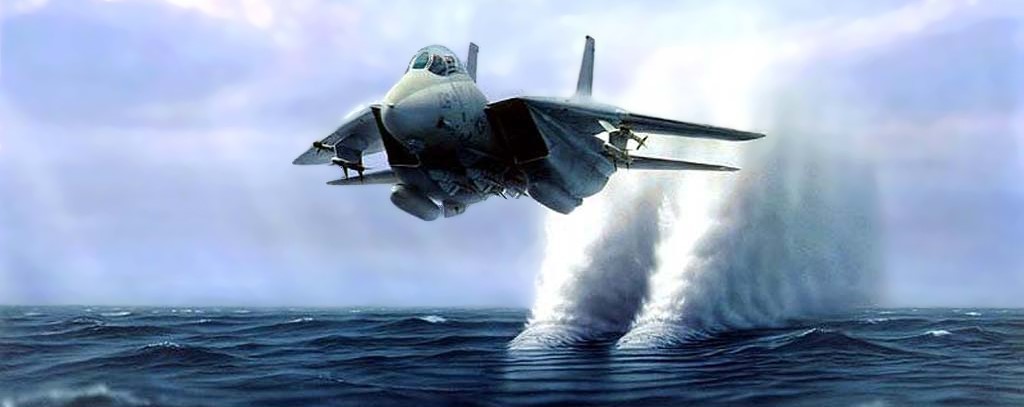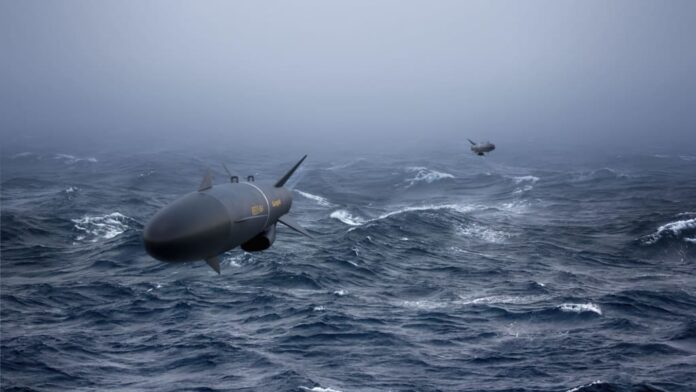Sea skimming is a technique many anti-ship missiles and some fighter or strike aircraft use to avoid radar, infrared detection. And it is also used to keep the lower probability of being shot down during their approach to the target. Basically, Sea-skimming is flying as close as possible to the sea surface.

Why sea skimming?
There are a couple of issues that make detecting a sea-skimming missile difficult. The success of sea-skimming missiles depends on their exact implementation, the infrared and radar signature of the missile, and the detection equipment’s sophistication.
It is more difficult for ships to detect sea-skimming missiles because of their late appearance due to the earth’s roundness and radar clutter from the sea. Suppose a ship’s radar is 20 m above the waterline (the SPY-1 panels on a DDG-51, for instance). In that case, a missile sea-skimming at 5m above the water clears the horizon 15nm from the ship: for a fast subsonic weapon like Exocet or Harpoon, that gives you ninety seconds to detect, initialize a track, realize the new track is a threat, assign weapons against it and engage. It sounds a lot until you have to do it: seconds disappear quickly in anti-air warfare.

The problem is that the sea-skimming missile is right down by the sea surface. This gets into some complicated radar physics, but one issue is “multipath,” where some of the radar energy reflects off the sea surface and then off the missile or vice versa.
This is further complicated by the missile’s movement towards the radar; so the net return seen by the radar, is the sum of the two paths – and because we’re dealing with radar waves, the different path lengths means the waves return with a phase difference, this means the return is sometimes stronger (constructive interference) and sometimes weaker (destructive interference).
This means it’s harder to form and hold a track – the radar demands several “good” returns to initiate a track on a possible contact, to avoid locking onto clutter and noise, and with this target fading in and out, it may keep failing the track-initiation criteria (for instance four good returns out of five scans) or drop the track as “weak, intermittent, probably just a glitch.”

The other problem is that the target appears to be in the wrong location since the radar image is the sum of all the returning energy. As the different paths interact, the centroid of the target return appears to move up and down, sometimes below the sea surface, sometimes above the target. A target-tracking radar will “nod” as it follows this distortion, and radar-directed weaponry will likewise be pointed at the wrong place.
There’s further issues about clutter (the background noise down at sea level that makes picking out the missile’s radar echo harder), ducting (where warmer, humid air at sea level refracts radar waves, making detection and accurate tracking more difficult) etc.
How does that work?
Performing sea-skimming is not just telling the missile to fly at a low altitude. Sea-skimming missiles carry a radio-altimeter that constantly measures the missile’s z-position concerning the sea surface and controls this position through a guidance & control loop.

There are two problems with sea skimming:
1. The probability of water impact increases
2. The water spray decreases the seeker’s efficiency
So what is the good flight altitude? And how to cope with sea conditions?
This is where it gets interesting: the missile can assess the sea state by itself. It measures the sea’s wavelength and the peak-to-peak height, estimates the sea state (usually from 1 to 9), and deduces the flight altitude at the best trade-off between stealth and probability of failure.
For instance, sea-skimmers usually fly around 5m above the sea surface for a calm sea (sea state 0 to 2) and approximately 20m above the sea surface for a rough sea (sea state 3 to 5).
Some Russian and Chinese sea-skimming anti-ship missiles are supersonic. Does the density of air at sea level limit its speed? Wouldn’t the missile experience extremely high temperatures? What are their limitations in terms of the seeker?
The missiles will get very, very hot at that speed and altitude. While heat is certainly an issue at those speeds/altitudes, its not necessarily the limiting factor. These are massive missiles that have heat shielding on them. The generated heat makes the use of IR seeker heads impossible though, so there are downsides. These missiles must use active radar homing seekers, and nothing else would work.

The real problem with increasing speed past Mach 3 through that air density is the ionized atmosphere it creates. This is similar to going through reentry, only it happens at a far lower speed because the air is so much more dense. Ionized gases and eventually the plasma that forms are opaque to the EM spectrum. In other words, the ionized atmosphere will block out radar waves and blind the missile. Around mach 3 for a sea skimming attack profile is likely a hard-ish limit, beyond which the missile won’t be able to “see” anything or receive datalink communications.
Related Article:
Are warships vulnerable to attack by surface skimming hypersonic anti-ship cruise missiles?
While the Russians claim that they can field such a weapon, there is no confirmed information about their missiles’ terminal phase speed.
While sea-skimming supersonic missiles generate a massive amount of heat, they can be built to compensate for this. The shape of the exterior must not change by much as the missile’s aerodynamic profile needs to be maintained; a slight bump at these speeds will generate enough turbulence to destabilize the missile, possibly sending it careening into the ocean. Therefore the exterior must be made from something that does not deform except at ridiculously high temperatures.
Next, you need to make sure that the delicate pieces such as the hydraulics and the electronic components aren’t heated to the point that they deform. Therefore, the second major engineering feat is to create an insulating layer to prevent the missile interior from being destroyed.
The sustained speeds of Mach 3 at sea or near sea level are improbable for most of the current supersonic anti-ship missiles. Missiles like Brahmos, for example, fly high and then go low at their terminal phase and travel at those speeds at sea level for a short amount of time.

Technological advancements, such as artificial intelligence usage in sea skimmer missiles and materials, are expected to minimize the disadvantages of supersonic/hypersonic missiles.
Check out Naval Library App to find out the specifications of the Anti Ship Missiles.





